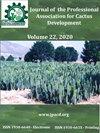Biology and chemistry of an Umbravirus like 2989 bp single stranded RNA as a possible causal agent for Opuntia stunting disease (engrosamiento de cladodios) - A Review
IF 0.4
4区 农林科学
Q4 HORTICULTURE
Journal of the Professional Association for Cactus Development
Pub Date : 2020-06-20
DOI:10.56890/jpacd.v21i.3
引用次数: 13
Abstract
Perhaps the most economically important disease of Opuntia ficus indica fruit cacti in Mexicois the “engrosamiento de cladodios” or macho disease. The symptoms of this disease, whichhas been suggested to be caused by a phytoplasma, are severe stunting of cladodes, flowersand fruits. In the mid-1980s this disease appeared in commercial cactus fruit orchards ofD’Arrigo Bros near Gonzalez, California. It was performed more than 30 PCR-based tests forviruses as well as various extraction methods and polymerase chain reaction (PCR) tests forphytoplasmas but were unable to find any of the known viruses or mycoplasmas in thestrongly symptomatic cactus with this disease. As almost all plant viruses go through areplication phase involving double stranded RNA (dsRNA), a dsRNA extraction wasperformed and a dsRNA species of about 600 bp identified. Then, reverse-transcribed thedsRNA, amplified the resultant cDNA by PCR, and cloned and sequenced the 600 bpfragment that were identified in symptomatic tissue. When this sequence was compared totranslated DNA in the National Center for Biotechnology Information (NCBI) nucleotide database (BLAST analysis) it was most similar to the Tobacco bushy top virus (E score of 2e-39),which is a single stranded RNA virus with no DNA intermediate. Primers made from this 630bp fragment were used to extend this sequence to 2989 sequence. This sequence appears tobe a full-length sequence with three open reading frames (ORF) and is shorter than theclosest class of viruses, the Umbraviruses that can be spread by mechanical transmissionand by aphids. It was not possible to transmit the virus or symptoms mechanically. Over asix-year period using traditional PCR, this virus was found in hundreds of symptomatic cactibut not in non-symptomatic pads. RT-PCR has found low levels of this virus on nonsymptomaticcladodes (3.7 fg) on a symptomatic plant and much higher concentrations(1x102 to 1x105 fg) on symptomatic cladodes from the same plant. Black bean aphids (Aphis fabae), that are the vector for a closely related Umbravirus known as groundnut rosetta virus,have been routinely found on the unopened flowers of cactus. This Umbravirus was found inaphids feeding on symptomatic cladodes. As Umbraviruses cannot infect plants without acompanion Luteovirus, that provides the protein coat for the Umbravirus, degenerateLuteovirus primers were used and a probable incomplete Luteovirus-like 4797 bp sequencewas found on aphids feeding on symptomatic cactus. This Luteovirus was not found inOpuntia cladodes using PCR. A micro RNA assembly of six pooled symptomatic Opuntiasdid not find a contig that spanned the 4797 putative Luteovirus sequence, but somefragments as large as 44 bp were exact matches to the Luteovirus. As Umbraviruses occurthroughout the plant but Luteoviruses only occur in the phloem, lower Luteovirusconcentrations would be expected. Two successive one hour 60°C heat treatmentseliminated these symptoms on new growth that was also PCR negative. A 5839 bpPotexvirus was found in some of these cladodes but its presence was not correlated with anysymptoms. Similar symptomatic cacti in Italy, South Africa and Mexico should be examinedwith these primers and dsRNA to see if similar correlations between presence/absence of thisfragment and symptomatic plants can be obtained. It is suggested that this disease be knownas OSD (Opuntia Stunting Disease).一种类似Umbravirus的2989 bp单链RNA可能是Opuntia发育迟缓病(engrosamiento de cladodios)致病因子的生物学和化学研究综述
也许墨西哥仙人掌最具经济意义的疾病是“engrosamiento de cladodios”或macho病。这种疾病的症状被认为是由植原体引起的,表现为枝条、花朵和果实的严重发育迟缓。20世纪80年代中期,这种疾病出现在加利福尼亚州冈萨雷斯附近的卡里戈兄弟商业仙人掌果园。它对病毒进行了30多次基于聚合酶链式反应的检测,并对植原体进行了各种提取方法和聚合酶链式反应(PCR)检测,但在症状严重的仙人掌中找不到任何已知的病毒或支原体。由于几乎所有的植物病毒都经历了涉及双链RNA(dsRNA)的复制阶段,因此进行了dsRNA提取,并鉴定出约600bp的dsRNA物种。然后,逆转录dsRNA,通过PCR扩增得到的cDNA,并克隆和测序在症状组织中鉴定的600bp片段。当将该序列与国家生物技术信息中心(NCBI)核苷酸数据库(BLAST分析)中的翻译DNA进行比较时,它与烟草浓密顶端病毒(E分为2e-39)最相似,烟草浓密顶端是一种没有DNA中间体的单链RNA病毒。使用由该630bp片段制成的引物将该序列扩展到2989序列。该序列似乎是一个具有三个开放阅读框(ORF)的全长序列,比最封闭的一类病毒,即可以通过机械传播和蚜虫传播的伞形病毒更短。不可能通过机械方式传播病毒或症状。在使用传统PCR的一年多时间里,这种病毒是在数百个有症状的仙人掌中发现的,而不是在无症状的仙人掌垫中。RT-PCR在有症状的植物的非症状分支上发现了低水平的这种病毒(3.7 fg),而在同一植物的有症状分支上则发现了更高的浓度(1x102至1x105 fg)。黑豆蚜(Aphis fabae)是一种密切相关的伞形病毒花生玫瑰塔病毒的载体,经常在仙人掌未开放的花朵上发现。这种伞状病毒是在以有症状的分支为食的成虫中发现的。由于伞状病毒不能在没有为伞状病毒提供蛋白质外壳的Luteovirus的情况下感染植物,因此使用了退化的Luteevirus引物,在以有症状的仙人掌为食的蚜虫身上发现了一个可能不完整的Luteavirus样4797bp序列。用聚合酶链式反应在仙人掌分支中未发现这种Luteovirus。六个合并症状仙人掌的微小RNA组装没有发现跨越4797个假定的Luteovirus序列的重叠群,但一些大至44bp的片段与Luteovius完全匹配。由于伞状病毒在整个植物中都有,但黄病毒只在韧皮部中出现,因此预计黄病毒的浓度会较低。连续两次1小时的60°C热处理消除了同样为PCR阴性的新生长物的这些症状。在其中一些分支中发现了5839 bpPotexvirus,但其存在与任何症状无关。意大利、南非和墨西哥的类似症状仙人掌应该用这些引物和dsRNA进行检测,看看是否可以获得该片段的存在/不存在与症状植物之间的相似相关性。建议将这种疾病称为OSD(仙人掌矮化病)。
本文章由计算机程序翻译,如有差异,请以英文原文为准。
求助全文
约1分钟内获得全文
求助全文
来源期刊

Journal of the Professional Association for Cactus Development
Agricultural and Biological Sciences-Plant Science
CiteScore
1.10
自引率
33.30%
发文量
10
期刊介绍:
The editors of the Journal of the Professional Association for Cactus Development, are very excited to be a part of the excellent editorial committee and to work together to create the synergism between scientists, growers, legislators, and business people so vital to the development of this industry to serve the people of arid lands.
 求助内容:
求助内容: 应助结果提醒方式:
应助结果提醒方式:


